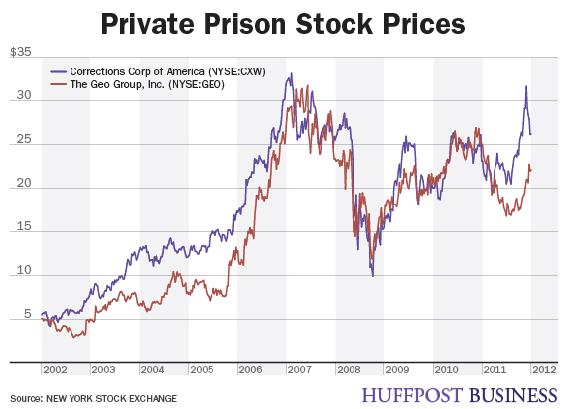10.2: Private sector
- Page ID
- 16145
Staffing and Employment Private facilities reported a total of 13,344 regular and non-payroll support staff. The number of full-time, or regular, staff ranged from as low as 19 at the smallest institution to 532 at the largest. Correctional officers accounted for 63.2 percent of employees at private facilities in 2015; a similar percentage were employed as security staff at public correctional facilities. Professional treatment staff accounted for 12 percent of private correctional employees, followed by clerical (7.9 percent), educational (5.8 percent), and maintenance and food service (5.5 percent).
Private state prisons have higher proportions of minority employees compared with public prisons. Fifty-three percent of the staff at private facilities were white (table 11), whereas 31.7 percent (table 8) of the inmate population was white. At public facilities, the corresponding figures in 1995 were 71.3 percent (table 11) and 35.5 percent (table 8), respectively. The racial composition of staff to inmates was similar for blacks at both types of facilities. Blacks comprise 22.4 percent of the staff and 43.9 percent of inmates at private state prisons versus 20 percent of staff and 47.7 percent of inmates at public facilities. Hispanics, on the other hand, comprise 14.4 percent of the inmate population at federal and state public facilities but only 6.3 percent of the correctional staff. Among the 65 private state facilities surveyed, Hispanics made up 20.7 percent of the inmate population and 18 percent of the staff.
When the three facilities located in Puerto Rico were excluded from the analysis, the private facilities still had a larger percentage of Hispanic staff (13 percent staff and 17 percent inmate population) than those employed at public facilities.
According to the United States Bureau of Labor, the average starting salary for correctional officers in 2016 was $32,290. The number of staff hired and terminated is largely driven by the number of facilities in operation and facility size—large and medium-sized institutions tend to have higher staff turnover rates. Only one private facility in the United States is unionized.
Correctional officers in privately operated prison facilities are becoming increasingly more available as growth in the private prison industry continues year after year. Regardless how you feel about private interests getting involved in the housing of prisoners and the building of detention facilities for profit, the fact remains that for those seeking employment as a corrections officer, this is a solid way to go.

Figure 10.3 Rise of Private Prison Stock Prices from 2002 to 2012. Creative Commons CC0 1.0 Universal Public Domain Dedication.
The privately-owned prison industry accounts for approximately 10% of the 2.3million prisoners currently being held in the United States at a cost of 55 million dollars per year.
There are a number of private prison operators in the United States but the two top companies are Corrections Corporation of America or (CCA) and The Geo Group, (GEO). Forty percent of the revenue that these companies receive is from the government for the housing of inmates and the operation of their private prison facilities. CCA is the largest private prison operator with about 67 facilities in the USA while The GEO Group has facilities both in the USA and internationally.

